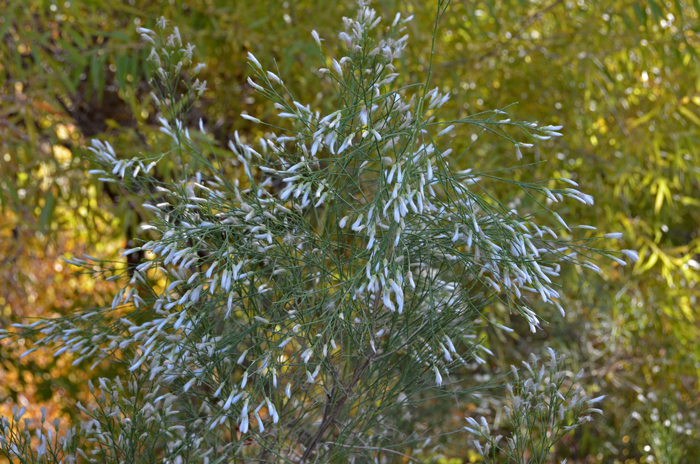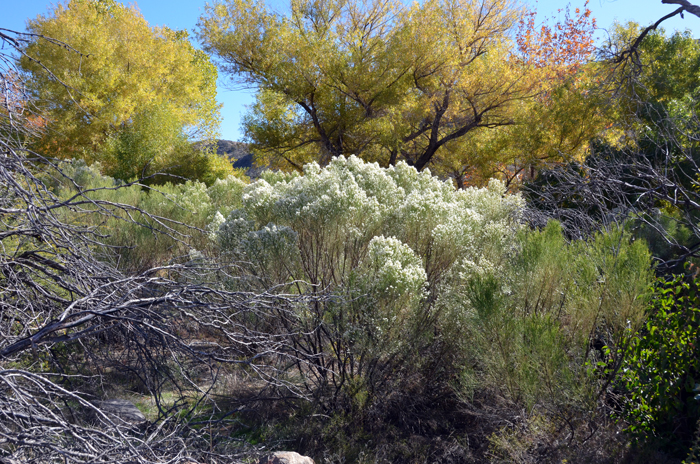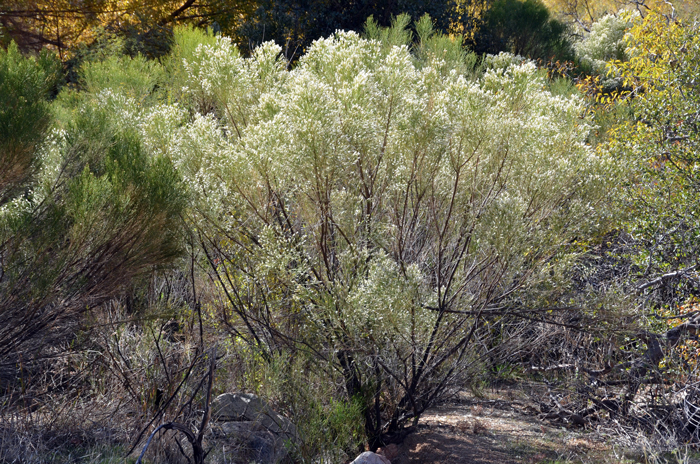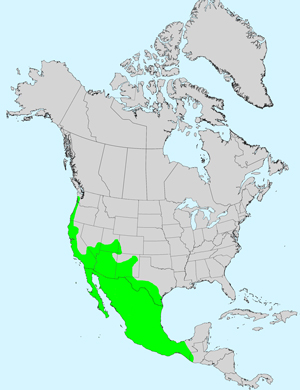Baccharis sarothroides, Desertbroom




Scientific Name: Baccharis sarothroides
Common Name: Desertbroom
Also Called: Broom Baccharis, Desert Broom, Greasewood, Groundsel, Rosin Bush; (Spanish: Romerillo, Hierba del Pasmo, Escoba Amarga).
Family: Asteraceae, Sunflower Family
Synonyms: (Baccharis arizonica)
Status: Native
Duration: Perennial
Size: Up to 12 feet (3.6 m)
Growth Form: Shrub; spreading whoody shrub; multiple green stems with parallel, longitudinal line or furrows (striate); branches broom-like and spindly; stems without hairs (glabrous) and with sticky sap (resinous along the primarily leafless green stems.
Leaves: Small bright green; alternate along stems; quickly deciduous and often leafless at flowering; leaf blades linear-oblanceolate, leaves without stems or other supporting stalks (sessile); leaf edges or margins not divided, smooth (entire), often rolled under (revolute).
Flower Color: Green, tiny; separate male (staminate) and female (pistillate) flowers in dense panicles; disk florets only; fruit is a cypsela attached to long feathery whitish bristles which float through the air.
Flowering Season: August, October, November often through February
Elevation: 1,000 to 5,500 feet (300-1,700 m)
Habitat Preferences: Mostly lower deserts, gravel dry and sandy washes, railroads, roadsides, flooded-areas, disturbed areas; saline soil and chaparral vegetation.
Recorded Range: In the Sonoran Desert in the southern southwest states of AZ, CA, AZ, NM, NV and TX, Baja California and northwest Mexico. Throughout most of Arizona. It is also native to Baja California, Baja California Sur and northwestern Mexico.
North America & US County Distribution Map for Baccharis sarothroides.
North America species range map for Baccharis sarothroides:
North American range map courtesy of Virginia Tech, Dept. of Forest Resources & Environmental Conservation

U.S. Weed Information: Unknown
Invasive/Noxious Weed Information: Unknown
Wetland Indicator: In North America Baccharis sarothroides has the following wetland designations: Arid West, FACU; Great Plains, FAC; Western Mountains, Valleys, and Coast, FACU.
FACU = Facultative Upland, usually occur in non-wetlands, but may occur in wetlands
FAC = Facultative, occur in wetlands and non-wetlands
Threatened/Endangered Information: Unknown
In the Southwestern United States: Arizona and California each have 10 species of Baccharis, Nevada has 5 species, New Mexico has 13 species, Texas has 12 species, Utah has 5 species. All data is approximate and subject to taxonomic changes.
Comments: As the vernacular name suggests Desertbroom, with its nearly leafless green stems, indeed has a broom-like profile. The many branches grow erect-ascending. The plant blooms profusely in the fall through early spring and at that time you might see the fine white feathery wind carried "parachutes" blowing freely in the air or covering the ground and the plant like a light snowfall dusting.
The type species (Eastwood 15832, 15833) for Desertbroom is from the Tonto Basin area, Gila County, Arizona
Also see in Southwest Desert Flora; Yerba de Pasmo Baccharis pteronioides and Seep Willow, Baccharis salicifolia.
The species epithet "sarothroides" (sarothro'ides:) means broom-like.
Baccharis sarothroides, Desertbroom has been used for several medicinal and other purposes by southwestern United States indigenous peoples.
See full species account from Native American Ethnobotany, University of Michigan, Dearborn.

